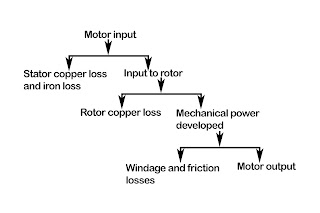Loss and efficiency of induction motor

What is loss?
We give electrical energy as input to
motor and mechanical energy as output. But the amount of energy we give input
is not entirely in the output.
{tocify} $title={Table of Contents}
That is, some amount of energy is wasted inside
the motor. And this is called loss of induction motor.
The figure below shows
the amount of loss from the induction motor to the electrical output to the
mechanical output.

How many types of loss?
According to the figure above, we see
4 types of losses. E.g.
1. Stator Copper
Loss
2. Stator Iron
Loss / Core Loss
3. Rotor Copper
Loss
4. Friction &
Windage Loss
We can also divide the loss of
induction motors into 2 more parts based on their nature. E.g.
1. Constant or
unchanging loss
2. Variable loss
Constant or unchanging loss
Losses that do not depend on the load,
that is, whatever type of load is applied to the shaft of the motor, will
always remain the same. The constant loss of motor can be measured through a no-load test. Constant loss can be further divided into 2 parts. E.g.
1. Stator Iron
Loss / Core Loss
2. Friction and
Windage Loss
Core loss
Eddie Current Loss and Hysteresis Loss
These two types of losses consist of Iron or Core Loss. By using laminated
cores we can reduce the amount of eddy current loss.
The laminated core reduces
the area and increases resistance. So the amount of eddy current is also
reduced a lot.
To reduce hysteresis loss, the core of
the motor should be made of low permeability material. Core loss depends a lot
on the frequency of the supply voltage. Because the supply voltage is always
given in the stator.
By core loss of motor, we mean a core loss of stator. This is
because the core loss of the rotor is so low that it can be ignored.
And since
there is no change in the supply frequency, the amount of loss is also fixed.
Hence it is called constant loss.
Friction and Windage Loss
This type of loss is due to motor
bearings and brushes. These losses depend on the speed of the motor. As the
speed increases, the Friction & Windage loss of the motor will also
increase.
And the speed of a three-phase induction motor is not usually
changed, so these losses are also called constant losses.
Variable loss
The copper loss of the stator and
rotor is the variable loss. The loss due to current flowing in the coil of the
stator and rotor is called copper loss. The level of current flow also changes
as the load changes.
As a result, the amount of loss is less - more. Hence
copper loss is called variable loss. Copper loss can be measured on an
induction motor by testing the blocking rotor. Suppose,
Stator current =
ISTA
Stator voltage =
ISTA
Rotor current =
IROOT
If the electrical power supply that we
give to the motor is PSUP, first, the stator enters the current in its coil. If
the electrical power supply that we give to the motor is PSUP, first the stator
enters the current in its coil and some energy from PSUP is expended as stator
copper loss, 3 (ISTA) 2R (three-phase motor is therefore multiplied by 3).
Then the current enters the core of
the stator where the stator core loss, 3 (VSTA) 2 / R occurs. Electrical power
then becomes mechanical power. The energy that remains in this state is called
air gap power, PAG.
The current then enters the rotor and the rotor loses some
energy in its coil as the rotor copper loss, 3 (IROT) 2R. Then after spending
some more energy as Friction & Windage Loss, we get the output power, POUT.
Efficiency of induction motor
Simply put, the ratio of output power
to input power is called efficiency.
Efficiency = Output Power / Input Power
A certain part of the amount of power or Psup that we gave to the induction motor is wasted
in different ways and then we get the output power i.e. Pout.
Now the ratio
of Pout to Psup will be called
the efficiency of the induction motor.
Efficiency = POUT / PSup ।
The relationship of efficiency with load is given below.

